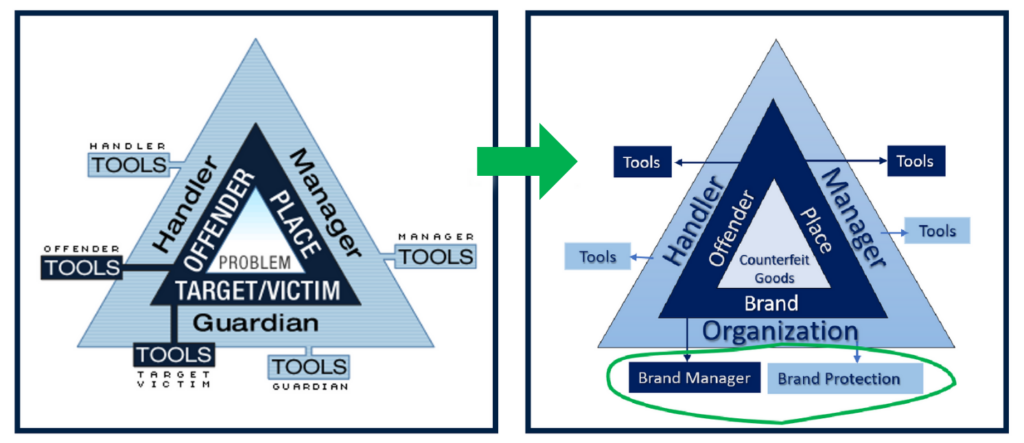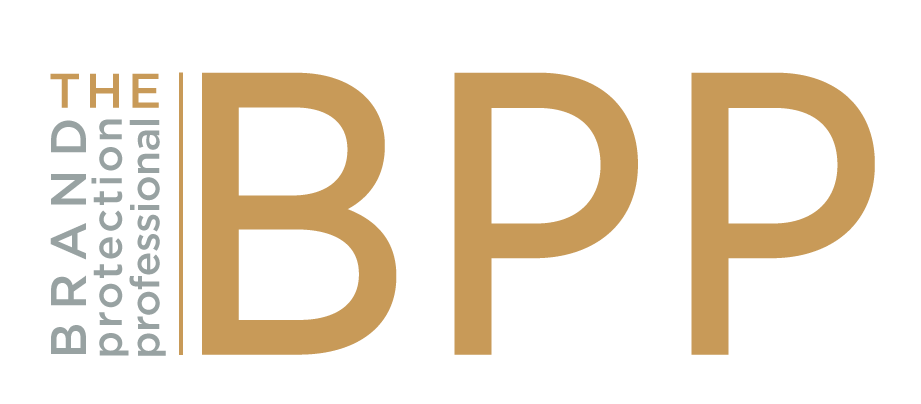Addressing the Counterfeit Crime Triangle
By Teaching Future Brand Protection Business Partners
Lisa O’Hal
Brand Protection Senior Manager, VF Corporation
Jimmy Kryskowiak
Brand Protection Manager, Church and Dwight
As brand protection professionals, we are tasked with quickly recognizing and addressing many issues that threaten our brands and victimize consumers worldwide. In our profession, investigating counterfeit sellers is the core focus but each brand/organization has specific investigative strategies they implement to combat counterfeit goods and disable the networks of counterfeiters, both online and on the ground. Factored into these strategies are the realities of variable resources: budget and personnel—which range widely and are subject to change based on many internal and external factors (most of which are not within the control of our brand protection teams). There is no single brand protection strategy that can be implemented by all brand protection teams. Our focus here is to propose a broader approach – a strategy that can be implemented by all brands, regardless of how big or small your brand protection team is – one that isn’t limited by budgets or the size of your team. It’s a strategy employed by many successful brands, across many different sectors:
Increasing the impact of brand enforcement efforts through Training, Education and Networking – all key components of a successful brand enforcement strategy.
Knowing It
Successful brand enforcement teams, partner with a broad network of agency and investigative partners, including law enforcement, government & regulatory agencies, and investigative firms, to help build cases at both state and federal levels. Making these connections is critical. Building solid relationships with investigative partners is best done in person whenever possible—through attending industry brand protection conferences and conducting trainings with agency partners, seizing every opportunity to educate officials about the products and brands we represent. Also, staying in touch with and updating industry partners with changes in products and authentication tools is an equally important component of a robust brand enforcement program.
Successful brand protection programs are built upon the foundation of relationships with law enforcement partners, focused on identifying and disrupting counterfeiters’ criminal networks. When combatting counterfeits, it all boils down to “crime prevention”; the development of strategies and measures to reduce the potential for a crime to occur. The Crime Triangle is a good way to visualize this crime. See Figure 1 Traditional Crime Triangle and Figure 2 Brand Protection Crime Triangle.

As depicted in Figure 2, brand protection strategies are a tool utilized by organizations to combat the illicit sale of counterfeit goods, implemented by brand managers, tasked with raising awareness about the threats of counterfeiting to consumers and safeguarding a brands’ reputational and fiscal value.
Teaching it
We took this same philosophy, focused on brand protection education, and applied it to a different audience – graduate school students in the Global Luxury & Management (GLAM) Master’s Program at North Carolina State University (NCSU). North Carolina Secretary of State Marshall joined Jimmy in teaching the first round of classes which brought the importance of the subject matter to light. We were then asked by Dr. John Kuzenski, Teaching Assistant Professor in Entrepreneurship, within the NCSU Department of Management Innovation & Entrepreneurship, to teach another course to his Ethics class. Following the course, Dr. Kuzenski related, “The inclusion of brand protection professionals presenting clear, meaningful data and discussing methods and strategies as a component of the class greatly enhanced student understanding and respect for the real world of business they were entering,” said Kuzenski. “It was also a refreshing lesion in applied ethics that gave students an accurate sense of the expensive magnitude of the counterfeiting problem for producers, vendors and clients alike. Students remained highly engaged with the content, asking questions, and wanting to do more research on related issues long after the presentation series had concluded.”
By introducing the topic of brand enforcement at the academic level and integrating these lessons into the GLAM curriculum, we educated students pursuing a master’s degree in the Management of Global and Luxury Brands on the dangers of counterfeiting and how it can negatively impact a brand’s reputation and value to consumers – especially luxury brands. Many students shared with us that learning about brand enforcement inspired them to look at their future careers through a different lens.
When developing our lessons for GLAM students, we referred to the Crime Triangle, and challenged students to insert themselves into the Crime Triangle, as future brand managers. Included in the GLAM Brand Enforcement curriculum were the following topics: Counterfeit and Trademark Law, The Dangers of Counterfeiting, The Size and Scope of Counterfeiting (Globally) and Application of Brand Protection Strategies to Future Careers.
After completing the GLAM program, one student (Jenna Firestein) remarked:
The brand enforcement presentations made a major impact on me personally and professionally. Personally, I’m now very careful when making online purchases, researching sites and marketplaces sellers before buying. What I learned about brand protection from these courses has also impacted by post-graduate professional career, as part of my job is working with my company’s Marketing and Legal Teams to make sure we are staying inside branding guidelines.“
Another student (Anastasia Manousaridis) said:
My knowledge of the counterfeit luxury goods industry prior to your presentation was pretty slim. I had seen counterfeit luxury goods abroad while traveling, but I never knew the impact it had on the industry and the negative consequences that came with it. Since completing the course, I have made efforts to educate others on the dangers of counterfeiting and the impact it can have. The presentation did impact my professional career as a sales associate. Thanks to what I learned, I am aware of the counterfeit crime that can go on within my store. Recently, a customer brought in an item that was very clearly counterfeit. The quality was poor but our logo was embellished on the item. The customer informed us the website she purchased them from seemed to be directly affiliated with the brand – she thought she was purchasing from an authorized site. Knowing what I now know about the negative impact of counterfeit goods, I brought the issue to my manager’s attention, with a request to communicate the information to our brand protection team. I am hoping to grow within the luxury goods industry and I’m glad I now understand the importance of asset and brand protection on a much larger scale. Brand protection is absolutely an important part of a brand’s success. It is a brand’s responsibility to ensure their goods aren’t being exploited and their trademarks are not being abused, used by criminal networks to produce counterfeit goods. It is also important to protect the brand from a business side, by protecting their intellectual property and creative rights.“
On two separate occasions, we presented to the GLAM students in Partnership with the School of Knowledge Economy and Management “SKEMA” school of business in Paris, France. The response from the first class was so overwhelming, we were invited back for a second session where we incorporated brand protection philosophies into the students’ ethics curriculum and helped students prepare final class projects incorporating brand protection learnings and takeaways from our lessons. When asked about their understanding of the brand protection industry and the importance of this function upon companies, GLAM graduate (Jenna Firestein) stated:
A brand’s most valuable asset is its history and reputation. Counterfeits tarnish a brand’s reputation, worth, and the value of products is diminished, to both consumers and brand-owners. Through this program, I learned that companies need their own in-house brand protection division to safeguard the value and reputation of the goods they produce.”
Extending our message about the dangers of counterfeiting and importance of brand protection outside of our industry to the students in the GLAM Master’s Program at North Carolina State University was a transformative experience for both of us, as teachers, and for the students with whom we interacted. The opportunity to speak about brand protection with audiences inside and outside of our industry circles is truly a privilege, and something we are passionate about continuing. Like many professionals, we have struggled to stay connected to our industry colleagues and partners through the pandemic. Participating in educational and outreach programs is one way we can all stay connected, whether virtually or when it’s safe to do so in person. Incorporating Training, Education and Networking into our brand protection playbooks is more than just a smart strategy, it keeps us connected as brand protection professionals and advances the importance and impact of our collective work.
THE BRAND PROTECTION PROFESSIONAL | MARCH 2022 | VOLUME 7 NUMBER 1
2022 COPYRIGHT MICHIGAN STATE UNIVERSITY BOARD OF TRUSTEES
- Next…
